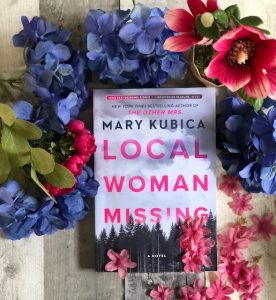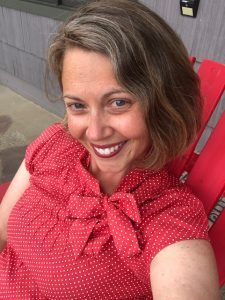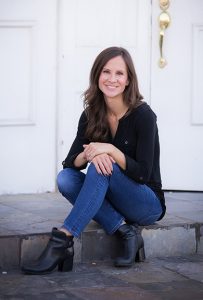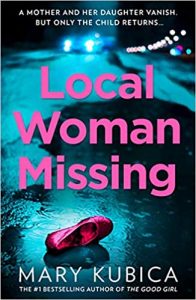Local Woman Writing: Interview with Mary Kubica
LOCAL WOMAN WRITING

Pic by Leslie Lindsay
I meet Mary Kubica outside at a darling coffee shop in downtown Plainfield, Illinois. She’s wearing a jacket, hands cupped around a warm coffee, even though its plenty warm outside, spring having recently—finally—arrived in the Chicago suburbs. She greets me with a warm smile and quick hug.
The coffee shop is closed to in-person dining, thanks to the pandemic, but they offer a walk-up window. Here, I glimpse the exposed brick walls, the whir of machines, and a delightful array of starburst pendants. The bar is empty.
“Don’t you miss writing in coffee shops?” We lament, almost in unison. Being excised from our favorite cafes is detriment to our creativity. There’s something about ambient noise, the hanging up of household and family obligations that offer a well of inspiration. We comment on the spill of spring blossoms, the umbrellas bobbing in the sun. We’re giddy with possibility.
The man at the window wants me to order. Mary always drinks coffee. Hot and black. It doesn’t matter the weather. For me, I say, “something cold…something fresh.” He rings me up for a hibiscus tea lemonade.
Mary and I have met to discuss all things bookish, but mostly her new book, LOCAL WOMAN MISSING, which is not autobiographical, although parts of it are. Like all good fiction, pieces are mined from Mary’s ‘real life,’ mostly her environs. “It’s comfortable to me,” she says, takes a sip, and nods toward Settler’s Park, “How about we do a loop or two around the lake?”
Like the rest of historic Plainfield, Settler’s Park is a wide expanse of green, a bubbling fountain in the middle of a large man-made lake, a footbridge, framed by the DuPage river. Walkers on their lunch hour speed past, parents entertaining babies on blankets, and the occasional dog greet us. Mostly, though, it’s a bevy of ducks and geese, a wink of sun. All of Mary’s books are dark, but she—and the day—are decidedly not. “One thing I’ve discovered about writing domestic suspense,” she says, “Is that it’s incredibly fun to make even the most idyllic settings feel ominous.”
Like Mary, I’m always crafting stories about the places I visit, even the ones right under my nose. Mary and I are both suburban Chicago moms. Mary grew up typing stories one finger at a time on an electric typewriter in her childhood kitchen. I grew up in a St. Louis suburb spinning stories on a desktop with a dot-matrix printer. I had always coveted those electric typewriters, clacking out my name and all the king’s men on machines in office supply stores, much to the chagrin of store managers. Unlike Mary, I learned to touch-type, thanks to Mavis Beacon Teaches Typing and an oppressive summer.
As kids, Mary and I were both readers, devouring popular YA books in the late 1980s, so it’s no surprise her work falls in line with the darker aspects of Lois Duncan.
“Every town,” she says, “Has it’s murky, mysterious places, whether abandoned homes or dark, isolated forests, or creepy roadside motels. You can do so much with that, and also the capricious Chicago weather.”
Almost as if on cue, the sun slips behind a cloud. Having just devoured Mary’s new book, rain slashing my windows, I have to ask, “So is LOCAL WOMAN MISSING set right here in Plainfield?”
Mary’s inquisitive eyes light up, but she doesn’t say, exactly. “I feel very at home writing about Chicago and the suburbs, which allows me more time and energy to focus on plot and character development.”
I get that. This story has a lot of elements from Mary’s earlier work.
“When I’m writing, I like to lose myself in the lives of my characters. Having a setting I know so well, it allows me to be more completely immersed.”
To be clear, LOCAL WOMAN MISSING is set in a leafy, rain-drenched historic town, reminiscent of Plainfield meets Naperville, Illinois. Her characters, Meredith and Josh Dickey live in a 1890s Queen Anne, which the couple restored, maintaining the historic integrity. Both Naperville and Plainfield are located on the National Register of Historic Places. Residing next door are Bea and Kate, a same-sex partnered couple who are in the midst of a messy renovation.
Kubica paints a vivid portrait of the yellow 1904 Italianate—which is just a stone’s throw from a college campus—lined with towering trees, a paved walkway. Inside, she alludes to historic ceiling medallions, original windows, and two sets of staircases: one gorgeous and prominent, for homeowners and guests, the other, narrow and curved, tucked out of the way, for servants. Which leads us to this: this is Mary’s first book featuring a same-sex couple.
Mary and I round the lake and decide to go around again, this time, footing over the arched bridge. She shares that her son, a middle schooler, often runs at Settler’s Park, it’s where the cross-country team practices. I can see why: the pathways are wide and smooth, there’s a slight grade.
She speaks about her daughter, too, a Freshman in high school, how they both felt apprehensive about starting milestone school year during a pandemic, the pure exhaustion of a new schedule. “Addison came home the first day and fell promptly asleep.” It’s no surprise then that she has dedicated LOCAL WOMAN MISSING to her children. We talk about the challenges of balancing a writing career with raising a family and settle on this: it’s important for our children to see us pursing our passions but family—soccer games and birthdays—are still number one.
Mary shares that one of her earlier manuscripts was ‘just not working.’ I nod sympathetically. “I even gave the characters my children’s middle names thinking that would allow me to be more emotionally invested. It helped, but it was still hard.” Writing is an exercise in persistence. It can be draining, wholly fatiguing.
LOCAL WOMAN MISSING opens with an exhausted new mother ‘bobbing a crying baby up and down like the needle of a sewing machine piercing fabric,’ and the suspicion of a cheating husband. Motherhood, as well as the greater Chicago area is almost always a prominent feature in Kubica’s work. In fact, her first book, THE GOOD GIRL was written in secret during her children’s nap times. “I didn’t want anyone to know what I was doing in case it didn’t amount to much.” Now, LOCAL WOMAN MISSING is her seventh book.
I don’t have to ask, because I already know: writing never gets easier. Each book brings new characters, situations, challenges. Writers are an astute bunch; we like to be challenged. For example, Meredith Dickey is a doula, she assists new mothers from the later stages of pregnancy through childbirth, and during the immediate newborn phase. A doula is an untrained (medically and obstetrically-speaking), but well-versed in pregnancy, labor, and newborns. She is often hired for support or a guide, an advocate for a new mother.
When I ask what the seed of inspiration was for LOCAL WOMAN MISSING, I am maybe expecting an answer along the lines of, “I wanted to know more about doulas,” but this is not the case. “We hear so often about missing people, but we don’t hear much about what happens to them when they return.”
As with all of Kubica’s books, there are always twists, misdirections. Is that crying baby at the beginning of the book the missing woman? Does that mother go missing? Who is she? Why do we care? These questions keep readers turning pages, and Kubica knows this. These ruminations allow her to show up at her desk day after day, too. “I try to rely on a number of small, developing mysteries that lead to the ultimate twist or twists.”
I think she’s on to something here: we need to keep the reader in a state of constant suspense, of sort of puzzling out the story for themselves; there’s so much white space that breathes on the page.
By now, we’ve made two loops around the shores of Settler’s Lake, and I am still eager for a history lesson. I want to know more about the neighborhood where LOCAL WOMAN MISSING is set. We’ve made our way back to the coffee shop. We need refills. I glance upward, taking in the two-story brick building, now painted white and trimmed in neat black. Dogwoods cast a pinkish hue on the façade. Later, I learn the Romanesque Revival building was rebuilt following a village fire in 1892. High above the second-story windows are blind brick arches, as if the eyes of the building in a perpetual state of surprise or inquisitiveness.
The man at the counter tells us the coffee shop was the original location of a pharmacy-soda fountain and quite possibly the first to serve an ice cream sundae. This delights us both.
To really get a sense of the locale in LOCAL WOMAN MISSING, a trip to Naperville, Illinois is in order. I check my watch. Mary checks hers. We both have things we need to do, and Naperville is not exactly ‘next-door.’ The fresh air will do us good, the camaraderie of another writer-mother might be exactly what we need to liberate stagnant thoughts, unleash a flurry of stories.
Before I-55 was built to the east of Plainfield, in the late 1950s, Lincoln Highway (IL Route 30) and U.S. Route 66, often referred to as “The Mother Road,” merged and crossed exactly in Plainfield, Illinois, making it the world’s largest paved highway. Somehow this astonishes me, all of these conduits of creativity, of motion colliding. It seems fitting. Mary and I caravan from this nexus of activity. We traverse the plains that now mostly contain shopping centers, hundreds of stoplights, and the occasional farmhouse tucked amidst the burgeoning corn fields. Corn is the crop of Illinois.
Naperville is decidedly more upscale, more crowded, but offers a scenic Riverwalk. Mary and I park and walk along the river. It’s often high this time of year, a combination of snowmelt and spring rains, and today it’s gurgling right along in jade green and olive undertones.
Mary points out a wooded area where she envisioned the body of one of the women surfacing in LOCAL WOMAN MISSING. In reality the Riverwalk is much more pedestrian than in the book. It’s a parade of babies in strollers, dogs on leashes, joggers.
There is very little here to suggest foul play, unless that underpass that echoes of graffiti, a slip on a mossy rock. Centennial Beach, a melding of swimming pool meets beach, a throwback to yesteryear stands ready to be filled, and here, Mary and I say, “There’s another place that could make it into a book.” I notice the high dives bobbing above and immediately conjure dark deaths. But come next month, the water will boast swimmers and kayakers, a sea of color and squeals of delight; we know of no such death or mystery there.
We loop around and make our way toward the college, near Brainerd and Benton Streets. I comment about my daughter’s Irish dance class, which takes place at historic church in that area, and Mary tells me her daughter also dances in the area, but everything has been on hiatus due to the pandemic. We both share how much we’ve read or written in parked cars while our children follow their passions. “Whole edits,” we say. “Research,” we add.
Neither Mary nor I went to school to become writers. Mary studied history and American literature at Miami University in Oxford, Ohio, and taught high school history for several years before having children and turning to writing full-time. My background is in nursing and psychology. We decide it doesn’t matter, though sometimes we admit to feeling like ‘outsiders,’ without M.F.A.s, or whatever we deem a proper author might have. Writing allows the gift of perspective, the ability to reflect, and both Kubica and I feel we arrived at publishing a little late in the game. “My mother said, when THE GOOD GIRL was released, ‘you’re in your early-to-mid-thirties when your first book is published, isn’t that kind of old?’” We laugh about that.
A writer’s life is varied and takes a circuitous path. We both had careers before: a teacher and a nurse. We married and had children. We write. Like the characters portrayed in LOCAL WOMAN MISSING, we are multifaceted, working mothers. Unlike those characters, we know exactly where we are.
The carillon sounds melodically in the distance, summoning us home. At this point, Kubica and I have meandered our way through Naperville’s Riverwalk, historic neighborhoods, and have blown the better part of three hours. We say our goodbyes and promise to be in touch soon. And yet, somehow, I am not sated.
The pleasure of strolling through nature with a sharp, observant mind like Kubica’s, discussing stories and motherhood, wondering about what goes on beyond the walls of those historic homes, have been hugely inspiring. I feel introspective, thoughtful. I note cupulas and walkways, I seek music studios in backyards, like the one where Bea from LOCAL WOMAN MISSING practiced her craft.
I long for a place like that to call my own, where I may churn out stories as trees arch over my roof, buds full and about to burst, honest and pregnant with ideas.
There is one last place I must venture to make my tour of LOCAL WOMAN MISSING complete and that is a roadside motel, which, lucky for me, is on the way home.
The motel is squat and dank, mustard-colored paint chipping from siding. A vacancy sign flashes. It invites me in. Mentally, viscerally, like a story.
—

Leslie Lindsay
Leslie Lindsay is the award-winning author of SPEAKING OF APRAXIA (Woodbine House, 2012). Her writing and photography have been published in various literary journals, most recently in Psychology Today and Brushfire Arts & Literary.
She drives a deep interest in place and how that shapes us, as well as the interstitial connection of family, dysfunction, and the symmetry and parallels of nature.
Since 2013, Leslie has interviewed over 700 bestselling and debut authors on her author interview series, Always with a Book, www.leslielindsay.com.
Her memoir, MODEL HOME: Motherhood, Madness & Memory is currently on submission with Catalyst Literary Management. SPEAKING OF APRAXIA will be published by Penguin Random House audio in July 2021. Leslie resides in the Chicago area.
Mary Kubica

Photo by Sarah Jastre
Mary Kubica is the New York Times and USA Today bestselling author of seven suspense novels, including THE GOOD GIRL, PRETTY BABY, DON’T YOU CRY, EVERY LAST LIE, WHEN THE LIGHTS GO OUT, THE OTHER MRS. and LOCAL WOMAN MISSING. A former high school history teacher, Mary holds a Bachelor of Arts degree from Miami University in Oxford, Ohio, in History and American Literature.
She lives outside of Chicago with her husband and two children. Her first novel THE GOOD GIRL was an Indie Next pick in August of 2014, received a Strand Critics Nomination for Best First Novel and was a nominee in the Goodreads Choice Awards in Debut Goodreads Author and in Mystery & Thriller for 2014.
Mary’s novels have been translated into over thirty languages and have sold over two million copies worldwide. She’s been described as “a helluva storyteller,” (Kirkus Reviews) and “a writer of vice-like control,” (Chicago Tribune), and her novels have been praised as “hypnotic” (People) and “thrilling and illuminating” (Los Angeles Times).
She is currently working on her next novel.
Find out more about Mary HERE
LOCAL WOMAN MISSING
 “Dark and twisty, with white-knuckle tension and jaw-dropping surprises.” —Riley Sager, New York Times bestselling author of Home Before Dark
“Dark and twisty, with white-knuckle tension and jaw-dropping surprises.” —Riley Sager, New York Times bestselling author of Home Before Dark
In this smart and chilling thriller, master of suspense Mary Kubica takes domestic secrets to a whole new level, showing that some people will stop at nothing to keep the truth buried.
People don’t just disappear without a trace…
Shelby Tebow is the first to go missing. Not long after, Meredith Dickey and her six-year-old daughter, Delilah, vanish just blocks away from where Shelby was last seen, striking fear into their once-peaceful community. Are these incidents connected? After an elusive search that yields more questions than answers, the case eventually goes cold.
Now, eleven years later, Delilah shockingly returns. Everyone wants to know what happened to her, but no one is prepared for what they’ll find…
BUY HERE
Category: Contemporary Women Writers, Interviews, On Writing






























